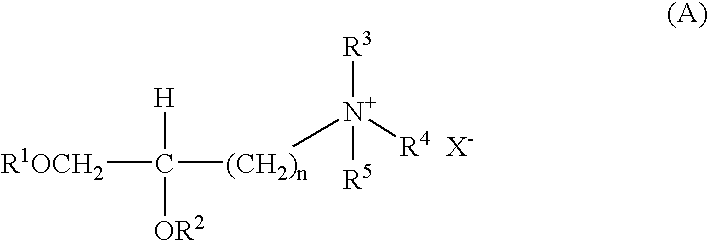Lipid-mediated polynucleotide administration to deliver a biologically active peptide and to induce a cellular immune response
a technology of lipid-mediated polynucleotide and cellular immune response, which is applied in the direction of peptide sources, transferases, growth hormones, etc., can solve the problems of delayed clinical application of gene therapy, possible genetic changes in the recipient cell, and damage to dna, so as to prolong the therapy over a long period of time and achieve safe and reliable results. , the effect of prolonging the therapy
- Summary
- Abstract
- Description
- Claims
- Application Information
AI Technical Summary
Benefits of technology
Problems solved by technology
Method used
Image
Examples
example 1
Preparation of Lioposme-Forming DOTAP
[0142]The cationic liposome-forming material 1,2-bis(oleoyloxy)-3-(trimethylammonio)propane (DOTAP) is prepared as reported by L. Stamatatos, et al. (supra) or H. Eibl, et al. (supra).
[0143]Briefly, Stamatatos, et al. report that 1 mmol of 3-bromo-1,2-propanediol (Aldrich) was acylated for 48 hours at 20° C. with 3 mmol of oleyl chloride (freshly prepared from oleic acid and oxaloyl chloride) in dry, alcohol-free diethyl ether (20 ml) containing 5 mmol of dry pyridine. The precipitate of pyridinium hydrochloride was filtered off, and the filtrate was concentrated under nitrogen and redissolved in 10 ml of hexane. The hexane solution was washed 3 times with an equal volume of 1:1 methanol / 0.1 N aqueous NCOONa, pH 3.0, 3 times with 1:1 methanol / 0.1 N aqueous NaOH, an d1 time with 1% aqueous NaCl. The crude 3-bromo-1,2-bis-(oleolyloxy)propane was then stirred for 72 hours in a sealed tube with a solution of 15% trimethylamine in dry dimethyl sulfoxi...
example 2
Preparation of Plasmids for Making DNA Templates for any Gene of Interest
[0144]Suitable template DNA for production of mRNA coding for a desired polypeptide may be prepared in accordance with standard recombinant DNA methodology. As has been previously reported (P. Kreig, et al., Nucleic Acids Res. 12:7057-7070 (1984)), a 5′ cap facilitates translation of the mRNA. Moreover, the 3′ flanking regions and the poly A tail are believed to increase the half life of the mRNA in vivo.
[0145]The readily-available SP6 cloning vector pSP64T provides 5′ and 3′ flanking regions from β-globin, an efficiently translated mRNA. The construction of this plasmid is detailed by Kreig, et al. (supra), and is hereby incorporated by this reference. Any cDNA containing an initiation codon can be introduced into this plasmid, and mRNA can be prepared from the resulting template DNA. This particular plasmid can be cut with BglII to insert any desired cDNA coding for a polypeptide of interest.
[0146]Although go...
example 3
Preparation of Plasmid Coding for Chloramphenicol Acetyltransferase
[0147]A convenient marker gene for demonstrating in vivo expression of exogenous polynucleotides is chloramphenicol acetyltransferase, CAT. A plasmid pSP-CAT containing the CAT gene flanked by the xenopus β-globin 5′ and 3′ sequences was produced by adding the CAT gene into the BgIII site of pSP64T. We used CAT gene in the form of the small BamHI / HindIII fragment from pSV2-CAT (available from the American Type Culture Collection, Rockville, Md., Accession No. 37155). However, the CAT gene is commonly used in molecular biology and is available from numerous sources. Both the CAT BamHI / HindIII fragment and the BgIII-cleaved pSP64T were incubated with the Klenow fragment to generate blunt ends, and were then ligated with T4 DNA ligase to form pSP-CAT.
[0148]The small PstI / HindIII fragment was then generated and purified, which comprises the CAT gene between the 5′ and 3′β-globin flanking sequences of pSP64T. pIBI31 (Inte...
PUM
| Property | Measurement | Unit |
|---|---|---|
| concentration | aaaaa | aaaaa |
| pH | aaaaa | aaaaa |
| pH | aaaaa | aaaaa |
Abstract
Description
Claims
Application Information
 Login to View More
Login to View More - R&D
- Intellectual Property
- Life Sciences
- Materials
- Tech Scout
- Unparalleled Data Quality
- Higher Quality Content
- 60% Fewer Hallucinations
Browse by: Latest US Patents, China's latest patents, Technical Efficacy Thesaurus, Application Domain, Technology Topic, Popular Technical Reports.
© 2025 PatSnap. All rights reserved.Legal|Privacy policy|Modern Slavery Act Transparency Statement|Sitemap|About US| Contact US: help@patsnap.com



